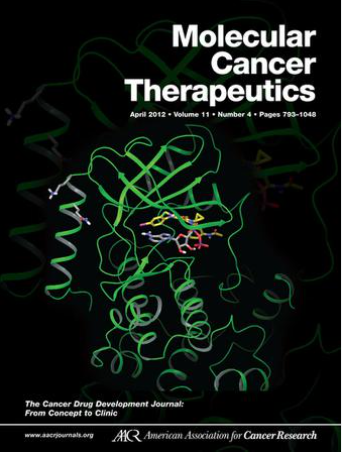Abstract A023: Determining genetic interaction from double knockout CRISPR screening
IF 5.3
2区 医学
Q1 ONCOLOGY
引用次数: 0
Abstract
Background For decades double knockout (KO) perturbation screens were limited to model organisms such as S. pombe and S. cerevisiae. CRISPR technology has revolutionized genetic interaction discovery by allowing large scale screening in human cell lines, organoids, and mouse models. However, there remains much uncertainty regarding the optimal way to determine the presence of genetic interaction from the raw data generated from these large scale double perturbation experiments. Here we compare two different analysis methods run on the same normalized dataset to determine to what degree does the analysis method influence the determination of genetic interaction. Methods A publicly available genetic interaction dataset containing 24,908 double knock-out constructs across three cell lines (Hela, A549, 293T) in four time points (day 3, 14, 21, 28) and two replicates generated from a pair-wise CRISPR-Cas9 KO screen was used for analysis (Shen et al, Nature Methods, 2017). These data were used to measure single gene fitness scores for 73 known cancer driver genes and all 2628 pair-wise interactions using (1) the numerical Bayesian method from Shen et al, called CTG (Compositional and Time-course-aware Genetic analysis), and (2) the variational Bayesian method GEMINI (Zamanighomi et al, Genome Biology, 2019). Results Single gene KO fitness measurements from CTG and GEMINI were highly correlated for all three cell lines (pearson r 0.678, 0.604, 0.784 for HeLa, A549, and 293T, respectively; p< 0.1 x10-8 for each). In contrast, correlation of genetic interaction scores between the two methods was essentially random: HeLa r= -0.0143, p= 0.47, A549; A549 r= -0.0476, p=0.015; 293T r= -0.0135, p= 0.49. Of 52 synthetic lethal interactions identified by CTG in HeLa at z-score cut off -3, none were identified by GEMINI at same Z cutoff. Conversely of 4 interactions identified by GEMINI, none were identified by CTG. Similarly in A549, of 57 interactions identified by CTG none were identified by GEMINI, of 3 interactions identified by GEMINI none were identified by CTG. Restricting to genetic interactions that were validated in low-throughput drug-drug assays, of 5 synthetic lethal interactions found in HeLa by CTG (CHEK1-MAP2K1, CHEK1-TYMS, ADA-CHEK1, ATM-CHEK1, CDK9-CHEK1) all but CHEK1-TYMS were validated in low-throughput assays. However none of the 5 were scored as hits by GEMINI. Of 3 interactions scored as synthetic lethal in A549 (PRKDC-RRM2, CDK9-PRKDC, CDK4-PRKDC) all but PRKDC-RRM2 were validated, none of the 3 were scored as hits by GEMINI. Conclusions This study highlights dramatic differences in calculated genetic interaction scores from two different computational algorithms applied to the same experimental data. With only 8 of 2628 (0.3%) interactions tested in validation experiments it is not currently possible to know the ground truth in order to assess which method is most accurate. The generation of synthetic genetic interaction data will be an important step for further optimization of algorithms to detect genetic interaction. Citation Format: John Paul Shen, Yue Gu, Saikat Chowdhury. Determining genetic interaction from double knockout CRISPR screening [abstract]. In: Proceedings of the AACR Special Conference in Cancer Research: Expanding and Translating Cancer Synthetic Vulnerabilities; 2024 Jun 10-13; Montreal, Quebec, Canada. Philadelphia (PA): AACR; Mol Cancer Ther 2024;23(6 Suppl):Abstract nr A023.摘要 A023:从双基因敲除CRISPR筛选中确定基因相互作用
背景 几十年来,双基因敲除(KO)扰乱筛选仅限于模式生物,如鼠李属(S. pombe)和酿酒鼠李属(S. cerevisiae)。CRISPR 技术允许在人类细胞系、器官组织和小鼠模型中进行大规模筛选,从而彻底改变了遗传相互作用的发现。然而,从这些大规模双扰动实验产生的原始数据中确定遗传相互作用是否存在的最佳方法仍存在很多不确定性。在此,我们比较了在同一归一化数据集上运行的两种不同分析方法,以确定分析方法在多大程度上影响遗传相互作用的判定。方法 我们使用了一个公开可用的遗传相互作用数据集进行分析,该数据集包含三个细胞系(Hela、A549、293T)在四个时间点(第3、14、21、28天)的24908个双基因敲除构建体,以及由成对CRISPR-Cas9 KO筛选产生的两个重复数据(Shen等人,Nature Methods, 2017)。这些数据被用来测量73个已知癌症驱动基因的单基因适合度得分,以及所有2628个配对交互作用,使用的方法包括:(1)Shen等人的数字贝叶斯方法,称为CTG(组成和时间历程感知遗传分析);(2)变异贝叶斯方法GEMINI(Zamanighomi等人,《基因组生物学》,2019年)。结果 CTG 和 GEMINI 的单基因 KO 适合度测量结果在所有三个细胞系中都高度相关(HeLa、A549 和 293T 的 pearson r 分别为 0.678、0.604、0.784;p< 0.1 x10-8)。相比之下,两种方法的遗传交互作用得分之间的相关性基本上是随机的:HeLa r=-0.0143,p= 0.47,A549;A549 r=-0.0476,p=0.015;293T r=-0.0135,p= 0.49。CTG 在 HeLa 中发现的 52 个合成致死相互作用(z-score 临界值-3)中,没有一个是 GEMINI 在相同的 Z 临界值下发现的。相反,在 GEMINI 发现的 4 种相互作用中,CTG 没有发现任何一种。同样,在 A549 中,CTG 发现的 57 个相互作用中没有一个被 GEMINI 发现,GEMINI 发现的 3 个相互作用中没有一个被 CTG 发现。仅限于在低通量药物检测中得到验证的基因相互作用,CTG 在 HeLa 中发现的 5 种合成致死相互作用(CHEK1-MAP2K1、CHEK1-TYMS、ADA-CHEK1、ATM-CHEK1、CDK9-CHEK1)中,除 CHEK1-TYMS 外,其余均在低通量检测中得到验证。然而,GEMINI 没有对这 5 个相互作用进行命中评分。在 A549 中被评为合成致死的 3 种相互作用(PRKDC-RRM2、CDK9-PRKDC、CDK4-PRKDC)中,除 PRKDC-RRM2 外,其他所有相互作用都得到了验证,但这 3 种相互作用均未被 GEMINI 评为命中。结论 本研究凸显了两种不同计算算法对相同实验数据所计算出的基因相互作用得分的巨大差异。在 2628 个相互作用中,只有 8 个(0.3%)在验证实验中进行了测试,因此目前无法了解基本真相,从而评估哪种方法最准确。合成遗传相互作用数据的生成将是进一步优化遗传相互作用检测算法的重要一步。引用格式:John Paul Shen, Yue Gu, Saikat Chowdhury.从双基因敲除 CRISPR 筛选中确定遗传相互作用 [摘要]。In:AACR 癌症研究特别会议论文集:扩展和转化癌症合成漏洞;2024 年 6 月 10-13 日;加拿大魁北克省蒙特利尔。费城(宾夕法尼亚州):AACR; Mol Cancer Ther 2024;23(6 Suppl):Abstract nr A023.
本文章由计算机程序翻译,如有差异,请以英文原文为准。
求助全文
约1分钟内获得全文
求助全文
来源期刊
CiteScore
11.20
自引率
1.80%
发文量
331
审稿时长
3 months
期刊介绍:
Molecular Cancer Therapeutics will focus on basic research that has implications for cancer therapeutics in the following areas: Experimental Cancer Therapeutics, Identification of Molecular Targets, Targets for Chemoprevention, New Models, Cancer Chemistry and Drug Discovery, Molecular and Cellular Pharmacology, Molecular Classification of Tumors, and Bioinformatics and Computational Molecular Biology. The journal provides a publication forum for these emerging disciplines that is focused specifically on cancer research. Papers are stringently reviewed and only those that report results of novel, timely, and significant research and meet high standards of scientific merit will be accepted for publication.

 求助内容:
求助内容: 应助结果提醒方式:
应助结果提醒方式:


